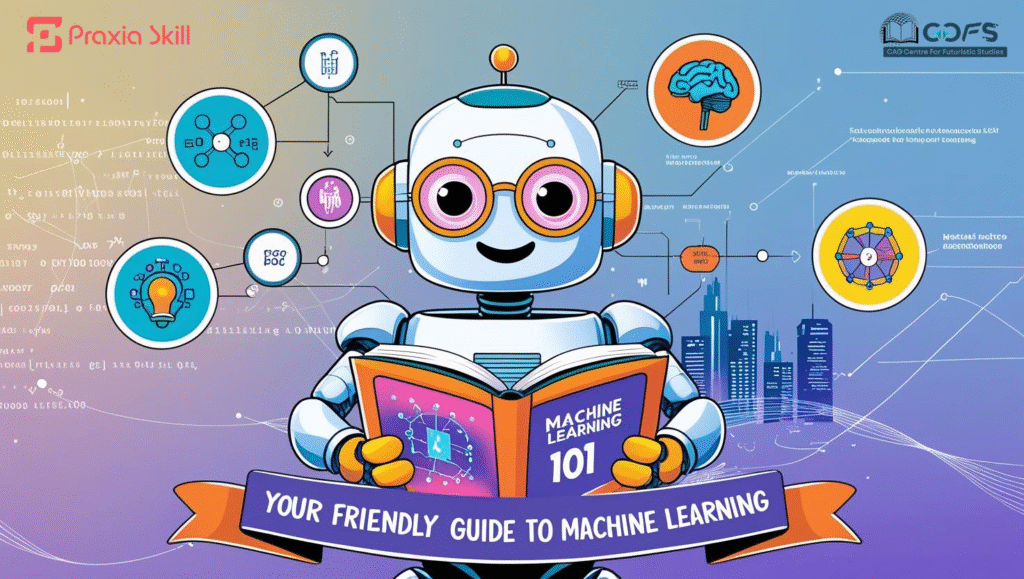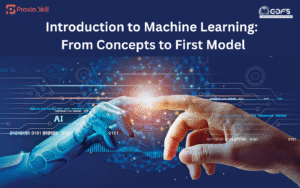What’s the Big Deal About Machine Learning?
Ever notice how Netflix just gets you, or your email inbox magically filters out spam? That’s not a coincidence—it’s Machine Learning (ML) working its magic.
At its core, machine learning is about teaching computers to learn from examples. Instead of you writing a long list of rules for every possible situation, you give the computer a ton of data and let it figure out the patterns on its own. It’s like giving a student thousands of flashcards and telling them to get good at guessing the right answer. Over time, their guesses get better and better.
AI vs. Machine Learning vs. Deep Learning: Clearing the Confusion
Have you ever heard the terms AI, Machine Learning, and Deep Learning and wondered what the difference is? It’s a common point of confusion. The easiest way to think about it is with a set of Russian nesting dolls.
Artificial Intelligence (AI) is the biggest doll. It’s the grand, overarching concept of creating machines that can think and act “smart.”
Machine Learning (ML) is the next doll down. It’s a specific method for achieving AI by teaching computers to learn from data, rather than being explicitly programmed for every single task.
Deep Learning (DL) is the smallest, innermost doll. It’s a specialized type of machine learning that uses complex, multi-layered structures called neural networks, which are inspired by the human brain.
So, while all three are related, they exist on different levels. AI is the broad goal, ML is the approach, and DL is a powerful tool within that approach.
How Machine Learning Works: The “Pet Training” Analogy
How does machine learning actually work?
Imagine you’re teaching a puppy to fetch. The process is surprisingly similar to how you “train” a computer.
- You provide examples: You toss a ball and say, “Fetch.” In machine learning, this is your data—thousands of images of cats, for instance. You’re giving the computer plenty of examples to learn from.
- You use a training method: You give the puppy a treat when it brings the ball back. In the world of ML, this is the algorithm—a set of rules that helps the computer learn patterns from the data.
- The puppy learns: After enough repetition, the puppy understands what “fetch” means and does it on command. The end result in ML is the model—a “trained” computer that has learned to correctly identify a cat in a new image it’s never seen before.
The Three Ways Computers Learn
ML models have different learning styles, just like people.
- Supervised Learning: This is like a student learning in a classroom with a teacher. The computer gets a dataset with both the questions and the correct answers. For example, a program learning to predict house prices gets a list of houses with details like size and location, along with their actual selling prices.

- Unsupervised Learning: This is for the curious explorers. The computer gets a bunch of data without any answers and has to find its own patterns. Imagine an online store grouping its customers into “bargain shoppers” and “premium buyers” without anyone telling the system what those groups are.
- Reinforcement Learning: This is all about trial and error. The computer tries something, and if it works, it gets a reward. If it fails, it gets a “punishment.” Over time, it learns to maximize its rewards. This is how an AI learns to play chess—it gets rewarded for winning moves and penalized for bad ones. It’s exactly like how you learned to ride a bike: you fell, you adjusted, and eventually, you rode smoothly.
Common ML Algorithms (for Beginners)
Don’t let the names scare you! These are just different recipes for learning:
- Linear Regression: Predicts a value based on a simple trend (e.g., predicting a student’s test score based on how many hours they studied).
- Decision Trees: A flowchart-like model that makes decisions by asking a series of questions.
- K-Nearest Neighbours (KNN): Finds the closest matches in past data to make a prediction.
- Naive Bayes: A simple, probability-based approach often used for things like spam filters.
- Random Forest: A “team” of decision trees that work together to make more accurate predictions.
The Not-So-Glamorous Side of ML
Machine learning is a powerful tool, but it’s not without its struggles. Behind all the impressive results, there are some messy problems to tackle.
- Data Bias: A model is only as good as the data it learns from. If the data is biased, the model will be too. For example, a hiring program trained on a company’s past hires, which were mostly men, might unintentionally favor male candidates. It’s a classic case of “garbage in, garbage out.”
- Overfitting: This happens when a model memorizes its training data instead of learning the general rules. Think of a student who just memorizes the answers from last year’s test. When the questions are different this year, they’ll fail. The model can’t handle new information because it only knows the old stuff.
- Explainability: Many of the most powerful ML models are like a “black box.” They can give you an incredibly accurate answer, but they can’t tell you why they came to that conclusion. It’s like a credit score system rejecting your loan without being able to explain which factors—like your job history or spending habits—tipped the scale.
How to Get Started with ML
Ready to dive in? Here’s a simple roadmap:
- Learn Python: It’s the most popular language for ML and has a ton of friendly libraries.
- Use beginner-friendly tools: Tools like Google Colab and the Scikit-learn library make it easy to start coding without a complex setup.
- Start small: Don’t try to build a self-driving car on day one. A great first project is a simple spam filter or a model that predicts house prices.
- Explore free resources: Websites like Coursera and Kaggle, along with countless YouTube tutorials, offer free courses and datasets to help you learn.
The Future of Machine Learning
ML is everywhere, and it’s just getting started. It won’t replace humans, but it will certainly change how we work and live.
- Hyper-Personalized Experiences: Imagine a streaming service that creates a show just for you based on your viewing history, or a doctor’s app that detects signs of disease from your voice or a selfie.
- AI as a Colleague: ML will increasingly act as a super-smart partner, helping us with brainstorming, data analysis, and automating boring, repetitive tasks.
The future of ML isn’t about machines becoming smarter than us—it’s about making our lives easier and more connected. So, what tiny ML project will you start with today?
Conclusion – Your Turn!
Machine learning isn’t just for experts in a lab. It’s a skill anyone can start learning today.
So, fire up your laptop, find a small project, and give it a try. You might be surprised at what you can teach a computer—and what you’ll learn yourself.



